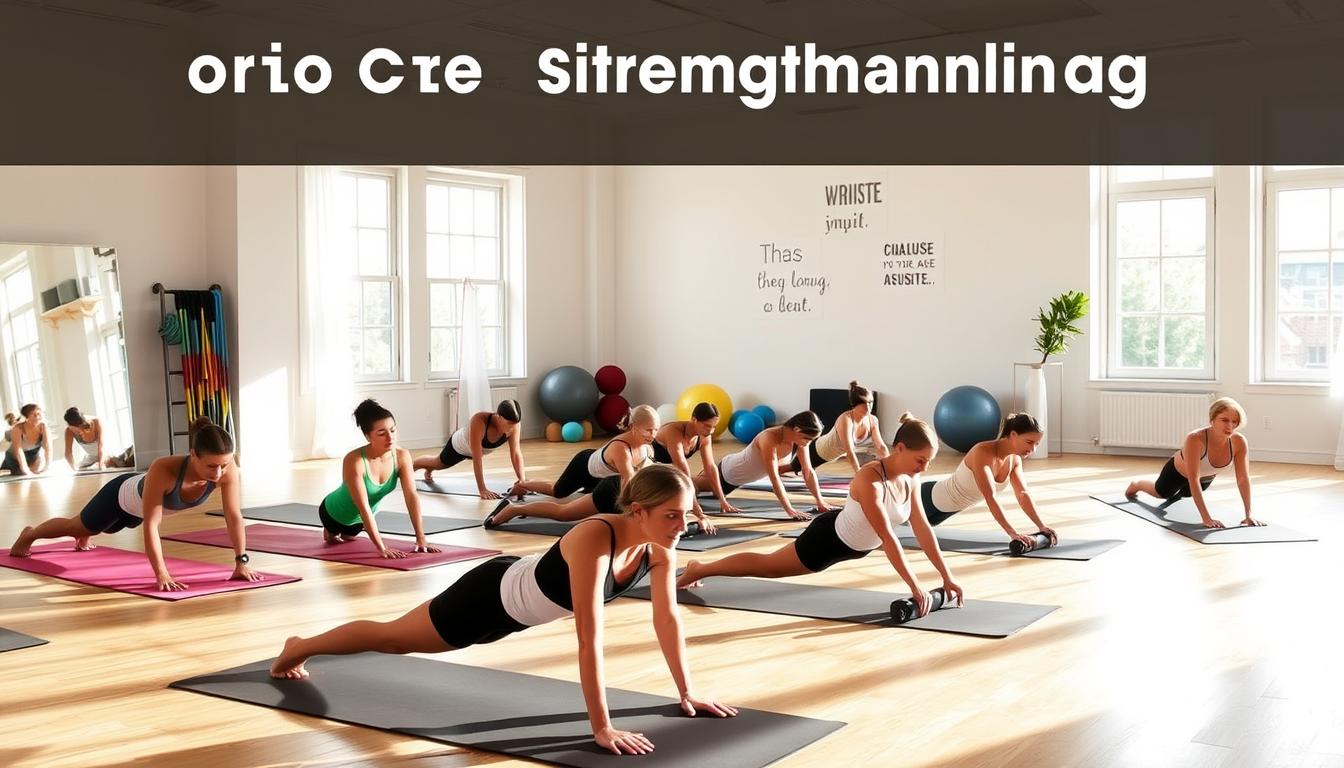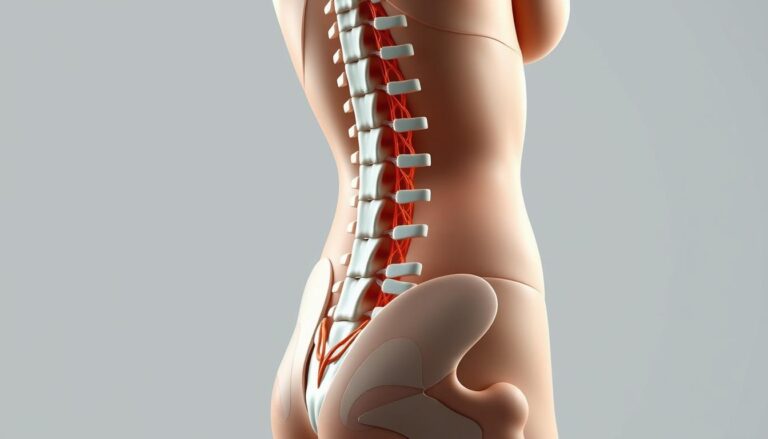Guide to Core Strengthening Exercises for Beginners
Embarking on a beginner core strengthening program requires a clear, actionable plan. This guide presents straightforward, scientifically-backed exercises and routines. It makes starting out both simple and reliable. Karen Asp, with her background in fitness journalism and personal training, offers both friendly advice and clinical insights.
Guidance from the Mayo Clinic emphasizes proper breathing and muscle engagement. For instance, focusing on the transversus abdominis and controlled breathing. Many exercises aim for 12–15 reps, while isometric holds last about three deep breaths. These numbers establish a safe starting point for beginners, avoiding unnecessary complexity.
Training the core is akin to planning a journey. Begin with accessible exercises that boost confidence. Then, progress to more challenging variations. The benefits are immediate and tangible: enhanced balance, smoother movements, and reduced stiffness during everyday activities like lifting groceries or bending to tie shoes.
Key Takeaways
- Core strengthening exercises for beginners focus on simple, repeatable moves to build a solid foundation.
- Follow Mayo Clinic-style breathing and aim for 12–15 reps or three-breath holds for isometrics.
- Karen Asp’s combined journalism and trainer background shapes approachable, reliable cues.
- Think of progress like travel: short, steady steps before longer, tougher challenges.
- Beginner core workouts quickly improve everyday tasks, posture, and balance.
Why Core Strength Matters for Everyday Movement
The core is more than just the abs; it’s a central hub connecting limbs and spine. It consists of muscles like the rectus abdominis, which flexes the torso, and the internal and external obliques for rotation and side-bending. The transverse abdominis wraps the trunk, while deep stabilizers such as the multifidus and pelvic floor provide additional support.
Beyond the front-and-back muscles, the erector spinae supports upright posture. The diaphragm coordinates breath with movement. Hip muscles, including the glutes, hamstrings, hip flexors, and adductors, attach to the pelvis, influencing how force is transferred from legs to torso. This network is crucial for beginners aiming for functional gains through core training.
What the Core Includes Beyond the Abs
The core acts as an internal corset and a power transfer system. The pelvic floor and diaphragm form a pressure chamber that stabilizes the spine during lifts or sudden moves. Glutes and hip muscles anchor the pelvis, enabling the trunk to work efficiently during activities like walking, climbing stairs, or carrying groceries.
Even simple tasks like fastening shoes, reaching into a high cabinet, or pushing a grocery cart require coordinated engagement from these muscle groups. Beginner-friendly core exercises should focus on stability, rotation, and breathing to mirror this complexity.
Benefits for Daily Life and Posture
Practical benefits of a balanced core strength are immediate. It reduces strain on the spine, improves trunk control, and makes everyday movements smoother. The Mayo Clinic emphasizes core work as part of healthy back care. A 2022 network meta-analysis also highlights core-based approaches as effective for chronic low back pain.
For beginners, basic core workouts offer significant benefits. A well-rounded program supports posture, prevents fatigue during chores, and reduces the risk of injury when lifting or carrying. This makes basic core workouts and beginner-friendly exercises a wise starting point for enhancing everyday resilience.
| Core Component | Primary Role | Everyday Example |
|---|---|---|
| Rectus Abdominis | Trunk flexion and forward support | Leaning forward to tie shoes |
| Obliques (Internal/External) | Rotation and side-bending control | Twisting to reach a shelf |
| Transverse Abdominis | Deep stabilization and intra-abdominal pressure | Maintaining posture while lifting a box |
| Multifidus & Erector Spinae | Spinal alignment and extension | Standing upright during long walks |
| Pelvic Floor & Diaphragm | Breath-posture interplay and pressure support | Bracing during a heavy carry |
| Glutes & Hip Muscles | Pelvic positioning and force transfer | Climbing stairs while holding a child |
Core Strengthening Exercises for Beginners
Building a strong core doesn’t have to be hard. Beginner core workouts focus on control, breathing, and movement quality. A simple, safe plan helps build habits and lowers injury risk.
Overview And Safe-Start Principles
Start on a carpeted floor or exercise mat, breathing deeply. Pull your navel towards your spine to engage the transversus abdominis. Imagine bracing like a gentle cough, not a hard flex. Focus on controlled movements and quality over quantity.
If you have back problems, osteoporosis, or health concerns, see a healthcare professional first. Mayo Clinic advises caution for those with medical conditions.
For dynamic moves, aim for 12–15 reps. For holds, aim for three deep breaths or 10–30 seconds, based on your ability. Rest between efforts to maintain technique.
Sample Beginner Moves To Start With
The bridge (glute bridge) starts with feet hip-width apart, knees bent. Lift hips until knees align with shoulders. Tighten your core and glutes. Hold for 10–30 seconds, repeating 3–5 times. This strengthens the posterior chain and improves pelvic stability.
The abdominal crunch involves keeping feet elevated or against a wall at a 90° angle to avoid neck strain. Cross your arms over your chest and lift your head and shoulders. Hold for three breaths. If you experience low back pain, reduce the number of reps.
Supine toe taps require lying on your back with knees at 90°. Lower one foot to tap the floor while keeping your back flat. This move teaches core control without stressing the spine.
Bird dog (quadruped) involves placing hands under shoulders, knees under hips. Extend the opposite arm and leg and hold for three breaths. It trains coordination and spinal stability.
Modified plank has forearms on the floor and knees down. Press your elbows and knees slightly toward each other and hold for three breaths. Progress by lifting an arm or leg for added challenge.
Side plank (knee or full) supports the lateral chain. Hold for three breaths per side, focusing on a straight line from head to hips.
Superman is a prone lift of arms and legs to target the lower back. Place a towel under your hips if extra comfort is needed.
How To Know When To Progress
Progress when your form is flawless and the move feels manageable without fatigue or soreness. Common progressions include longer holds, extra repetitions, shorter rests, or controlled variations like a single-leg bridge or bird dog with elbow-to-knee.
Gradually increase load and complexity. American College of Sports Medicine principles advocate for steady, incremental changes rather than big jumps in intensity. When exercise feels easy and precise, it’s time to move to the next step.
Simple Core Exercises You Can Do at Home
Start with a short intro to set a calm, practical tone. These simple core exercises fit small spaces and require no special gear. They work well for daily movement and for people who want beginner ab exercises that feel safe and steady.
Equipment-Free Exercises With Cues
Bridge: Lie on your back with knees bent and feet hip-width. Squeeze the glutes and lift hips until knees align with shoulders. Keep a neutral spine and breathe out on the lift.
Modified plank: Support on forearms and knees. Keep a straight line from head to hips. Avoid sagging at the hips; hold for three steady breaths.
Bird dog: Start on hands and knees. Reach long through opposite arm and leg. Keep hips level and neck neutral while pressing the core into the shape.
Supine toe taps: Lie on your back and pull the navel toward the spine. Tap one foot gently at a time while keeping the lower back on the mat.
Crunch (gentle): Cross hands on the chest, tuck the chin, and lift the shoulders slightly. Lift with the ribs, not the neck, to protect the cervical spine.
Side-lying knee-supported side plank: Place forearm under the shoulder and stack the knees. Lift hips up and hold with a steady breath.
Single-leg abdominal press (Mayo Clinic variation): Press one hand into the knee to create resistance while bracing the core. Keep the motion controlled and slow.
Setup and Environment
Use a yoga mat or a carpeted surface for cushioning. Make sure there is enough floor space to extend arms and legs. Wear comfortable clothing and supportive shoes if preferred.
Choose a quiet, distraction-free corner. Keep a wall or chair nearby for balance support during transitions. Light a lamp or position near a window for pleasant visibility.
Breathe and pace the session: inhale to prepare, exhale during the effort. Hold isometric moves for about three deep breaths to match common clinical guidance.
Practical tips: Begin with a brief warm-up such as light marching in place and gentle hip circles. Finish with a short cool-down and spinal mobility moves. Stay hydrated and rest between sets as needed.
Foundational Core Workouts for Beginners
For new exercisers, core workouts should be brief, straightforward, and goal-oriented. A few focused routines can enhance control, strength, and daily function without overloading the body. These foundational core workouts employ simple moves that fit most schedules and fitness levels.
Short Routines For Different Goals
The Stability Starter (10–15 minutes) includes pelvic tilts 8–12, bird dogs 8–12 each side, modified plank 3 × 20–30 sec, and bridges 3 × 10–15. This routine enhances spinal control and mobility.
The Strength Builder (15–20 minutes) targets abdominal and glute strength. It includes supine toe taps 3 × 12, crunches 2 × 8–12, side plank 2 × 20–30 sec each side, and single-leg bridge 2 × 8–10 each side. This set is designed to progress from basic core workouts.
The Functional Flow (15 minutes) starts with a light dynamic warm-up. It then moves to bird dog with elbow-to-knee 2 × 8–12, standing farmer-carry variation with an unloaded or light object, and plank variations 3 × 30 sec. This flow connects movement patterns to everyday tasks, highlighting beginner-friendly core exercises.
Sample Weekly Schedule
- Monday: Stability Starter
- Tuesday: Active recovery — walking or gentle mobility
- Wednesday: Strength Builder
- Thursday: Active recovery or light cardio
- Friday: Functional Flow
- Saturday: Optional light practice — repeat any routine or focus on mobility
- Sunday: Rest
Begin with 1–2 dedicated core sessions per week if overall activity is low. As tolerance improves, add a third session or fold these routines into full-body workouts. Follow ACSM-style progression by increasing reps, sets, or holds while keeping form first.
Beginner-Friendly Core Exercises For Improving Stability
The body learns balance through small, repeatable challenges. Beginner-friendly core exercises build that foundation with low-risk moves. These exercises teach the nervous system to coordinate spine, hips, and shoulders. They fit into core training for beginners routines and pair well with simple core exercises done at home.
Start with controlled tempo and brief holds. Focus on steady breathing and quality of movement. Progress only when control is consistent for three sets of the chosen work.
Exercises That Target Balance and Coordination
- Bird dog: reach opposite arm and leg, pause, then return. Add an elbow-to-knee touch to increase coordination without heavy load.
- Single-leg bridge: push through one heel to raise hips, keep the pelvis level. Swap sides to even out strength and stability.
- Single-leg stance with gentle trunk rotation: stand tall, rotate torso slowly while keeping the standing hip steady.
- Side plank progressions: begin on the knee, hold steady, then extend to full side plank as balance improves.
- Modified plank with alternating limb lifts: lift one arm or leg briefly to train anti-rotation and shoulder-hip linkage.
How Stability Work Reduces Low Back Pain Risk
Deep stabilizers like the transverse abdominis and multifidus act as internal corsets for the spine. Strengthening them lessens shear forces on vertebrae and eases the load during daily tasks.
Hip and glute strength helps redistribute forces away from the lumbar spine during lifting and bending. When hips and glutes do their job, the lower back is under less strain.
Coordination training improves timing of muscle activation. Better timing prevents compensatory patterns that can provoke pain. Clinical guidance from sources such as Mayo Clinic supports gradual progressions and activation of the transversus abdominis for people with back concerns.
If pain exists, consult a clinician before increasing load. Core training for beginners should feel manageable and safe. Use simple core exercises to build confidence, then layer more challenge as control and comfort allow.
Beginner Ab Exercises With Proper Breathing And Form
Good form and steady breathing transform simple moves into effective progress. Beginner core workouts start with precise cues that target deep muscles without strain. Focusing on technique speeds up gains and reduces aches.
How To Engage The Deep Core Correctly
Begin each rep with a calm inhale to prepare. On the exhale, draw the belly button gently toward the spine, as if lacing a corset. This action engages the transversus abdominis, a deep layer crucial for stabilizing the pelvis and low back.
The cough test can help find the right spot. A gentle cough mimics the contraction needed during beginner core workouts. Match this sensation to quiet bracing during slow movements.
It’s important to maintain a neutral spine and pelvis. Avoid pushing the low back flat to the floor or letting the ribs flare up. Neutral alignment ensures breathing and bracing work together effectively during core strengthening exercises for beginners.
Common Form Mistakes And Fixes
Neck strain during crunches is common. To avoid it, cross your arms on your chest and tuck your chin. Lift your shoulders with your abs, not your neck.
Sagging hips in planks reduce effectiveness. Slightly raise your hips and squeeze your glutes. Imagine a straight line from head to heels to maintain alignment during beginner ab exercises.
Overarching the lower back in bridges comes from forcing the hip drive. Keep your spine neutral and press through your heels while engaging your glutes. Stop short of full spinal extension to protect your lumbar region.
Holding your breath or taking shallow breaths blunts the benefit. For isometric holds, start with three deep, steady breaths. This rhythm supports oxygen flow and keeps the brace effective.
Rushed reps trade quality for quantity. Slow down and focus on control. Early gains from core strengthening exercises for beginners come from precise, measured reps rather than speed.
Monitor your effort and safety. Start with low volumes and progress when repetitions and holds feel stable. If sharp or radiating pain appears, stop and seek professional advice. Thoughtful pacing keeps beginner core workouts safe and sustainable.
Building A Beginner Core Strengthening Program
Begin with clear goals and a simple plan. A beginner core strengthening program should focus on movement quality, steady overload, and balanced variety. Short sessions twice a week give the body time to adapt while teaching proper breathing and pelvic control.
Progression Principles And Programming Tips
Increase load gradually. Raise reps, sets, hold time, or movement complexity in small steps to avoid setbacks. Keep neutral spine, controlled breath, and a stable pelvis across every progression.
Mix stability-focused work with strength sessions. Include anti-extension moves like planks, anti-rotation holds such as Pallof-style variations, and controlled flexion/extension exercises like crunches and supermans. Start sessions with 5–7 minutes of light cardio and mobility for the hips and lumbar region.
Begin with two nonconsecutive sessions per week. When recovery is solid, add a third day. Reduce rest between sets or add an extra set to increase stimulus while preserving form. Schedule low-intensity active recovery days to aid adaptation.
When To Add Resistance Or Advanced Variations
Introduce light external load only after bodyweight basics are mastered and form is consistent across the planned sets and reps. Dumbbells or kettlebells work well for loaded carries and resisted twists.
Use unilateral challenges to reveal imbalances. Single-leg bridges and single-arm planks force each side to work independently, exposing weak links that basic core workouts might miss.
Move toward intermediate moves when the beginner can hold base positions and hit time or rep targets reliably. Progress to full planks, mountain climbers, side plank rotations, or Turkish get-ups once control is evident and shoulder and hip stability are solid.
| Phase | Frequency | Focus | Examples |
|---|---|---|---|
| Foundation | 2× per week | Form, breathing, basic endurance | Plank holds 3×20–40s, bird-dog 3×8 per side, glute bridge 3×10 |
| Build | 2–3× per week | Strength, stability, progressive core training | Side plank 3×20–30s, Pallof hold 3×12–15s, dead bug 3×10 |
| Advance | 3× per week | Loaded and unilateral work | Single-leg bridge 3×8, suitcase carry 3×30–60s, Turkish get-up progressions |
Keep notes each session. Track hold times, reps, rest, and perceived exertion. Use that log to adjust volume and to ensure the beginner core strengthening program grows without hasty jumps.
Basic core workouts are best when tailored to daily needs. Progressive core training should feel steady, measurable, and grounded in safe load increments aligned with ACSM-like coaching checks for shoulder and hip stability.
Common Concerns And Safety Considerations For Beginners
Starting core work brings up several important questions. Taking simple precautions ensures sessions are productive and minimizes the risk of setbacks. Below, we discuss when to pause, who to consult, and how to modify exercises for specific needs.
When To Get Medical Or Professional Advice
If you experience persistent low back pain or sharp pains that radiate down your leg, seek medical advice before beginning new exercises. Conditions like recent surgery, osteoporosis, or pregnancy also warrant a consultation. Any pain that worsens during or after exercising is a clear sign to stop and seek professional evaluation.
Certified trainers and licensed physical therapists can provide personalized assessments and create customized plans. The Mayo Clinic and many rehabilitation centers advocate for individualized progressions and rep schemes to ensure safe and effective gains. They can also identify form issues that may lead to injuries.
Modifications For Injuries, Pregnancy, And Limited Mobility
Pregnancy-friendly core exercises focus on pelvic-floor-safe movements and avoid prolonged flat-on-the-back positions after the first trimester. Standing anti-rotation drills and side-lying clams are effective for building strength without excessive pressure. Prenatal exercise specialists offer targeted guidance.
For individuals with low back pain, opt for low-load, high-control exercises like bird dog, prone or supine bridges, and gentle supine toe taps. Avoid aggressive flexion if it exacerbates symptoms. A graded exposure plan under professional guidance helps rebuild tolerance.
Limited mobility or joint concerns benefit from seated bracing drills, isometric holds, and water-based sessions that reduce load while enhancing control. For those with osteoporosis, avoid heavy spinal flexion and focus on extension and stability with professional input.
Practical Safety Tips
- Focus on proper form over the number of reps; quality is key to building lasting strength.
- Use steady breathing; exhale during effort to protect the spine and pelvic floor.
- Progress slowly; small increases in load or time are more effective than sudden jumps.
- Utilize simple props like a towel under the hips or a yoga block for comfort and alignment.
- Ensure the environment is safe: use a non-slip mat and keep the area clutter-free to reduce fall risk.
These safety considerations and modifications for core exercises empower beginners to explore strength training with confidence. If in doubt, a brief consultation with a trusted professional can help ensure steady and safe progress.
Conclusion
Simple, steady practice of core strengthening exercises for beginners turns small efforts into lasting ability. Starting with easy core strengthening routines—planks, dead bugs, and gentle anti-rotation moves—builds stability and mobility. These skills show up in everyday tasks like lifting groceries or walking stairs.
Keep cues clear: breathe, brace the deep core (transverse abdominis), and prioritize form over reps. Follow gradual progressions grounded in resistance-training basics and clinical guidance from sources like the Mayo Clinic and the American College of Sports Medicine. This approach lowers injury risk and helps transfers from beginner core workouts to more dynamic movement.
Treat early sessions like short trips—ten to twenty minutes, often, with variety added over time. Track gains by better posture, longer holds, and cleaner form rather than chasing heavy numbers. When pain or special conditions arise, seek professional advice to adapt movements safely.
Viewed as an investment in daily movement, consistent beginner core workouts pay off in resilience, balance, and freedom to move. Start small, stay curious, and let steady progress widen the map of what the body can do.
FAQ
What exactly is the “core” and which muscles should beginners focus on?
The core encompasses more than the visible “six-pack.” It includes muscles like the rectus abdominis, internal and external obliques, and the transverse abdominis. The transverse abdominis is the deep stabilizer. It also includes the erector spinae, multifidus, pelvic floor, diaphragm, glutes, and hip muscles. Beginners should focus on recruiting the transverse abdominis and training pelvic and glute stability. This creates balanced, functional support for everyday tasks.
How do I breathe and brace properly during beginner core workouts?
Start by inhaling, then exhale while drawing your navel toward your spine. Imagine creating a firm corset, not a violent suck-in. Use the cough test to find the right muscles. Feel the contraction during a cough and mimic that gentle brace. For isometric holds, time efforts to three deep breaths, as suggested by the Mayo Clinic.
What are safe-start principles and how many reps or holds should a beginner do?
Start on a carpet or mat, focus on controlled tempo, and prioritize quality over quantity. For dynamic moves, aim for one set of 12–15 reps. For isometric holds, begin with three deep breaths or 10–30 seconds, depending on ability. If you have back problems, osteoporosis, or other concerns, consult a clinician before starting.
Which simple core exercises are best for absolute beginners at home?
Start with equipment-free, easy-to-learn moves like the bridge, modified plank, bird dog, and supine toe taps. Gentle crunches, knee-supported side plank, and superman lifts are also good. Each exercise has clear cues: brace the core, maintain a neutral spine, and move slowly. These exercises build foundational stability and control.
How can I progress when a beginner move starts to feel easy?
Progress gradually by increasing hold time or reps, adding sets, or shortening rest. Introduce controlled variations like single-leg bridge or bird dog with elbow-to-knee. When form stays flawless and exercises feel manageable, consider small increments in load or complexity. Always follow ACSM principles for safe overload.
What short routines should a beginner try to build a consistent habit?
Start with a 10–15 minute Stability Starter routine. This includes pelvic tilts, bird dogs, modified planks, and bridges. For strength, use a 15–20 minute Strength Builder routine. This includes supine toe taps, crunches, side planks, and single-leg bridges. Aim for 2 sessions per week at first, increasing to 3 nonconsecutive sessions as tolerance improves.
Can core training reduce low back pain and how does it work?
Yes, core training can reduce low back pain. Strengthening deep stabilizers and improving hip/glute strength reduces load on the lumbar spine. This improves timing of muscle activation. Clinical guidance from the Mayo Clinic and a 2022 network meta-analysis note core-based approaches as effective options for chronic low back pain. Always consult a clinician for persistent or radiating pain.
What common mistakes should beginners avoid when doing core exercises?
Avoid neck tension during crunches by tucking the chin and lifting with the core. Prevent hip over-extension in bridges by keeping a neutral spine and driving through glutes. Stop sagging hips in planks by lifting the pelvis slightly and engaging glutes. Slow down reps, breathe rhythmically, and stop if sharp or radiating pain occurs.
When should I seek medical or professional advice before starting a beginner core strengthening program?
Consult a physician or physical therapist if you have existing low back pain, recent surgery, osteoporosis, pregnancy, or any condition that limits mobility. Seek a certified personal trainer or physical therapist for individualized progressions if form or pain is a concern.
How can beginners adapt exercises for pregnancy, injury, or limited mobility?
Modify exercises by choosing pelvic floor–friendly moves and avoiding prolonged supine positions after the first trimester. Use side-lying or standing core options. For low back pain, prioritize low-load, high-control exercises like bird dog and supine toe taps. For limited mobility, use seated bracing drills, isometric holds, or water-based core work. Always get personalized clearance from a healthcare provider.




